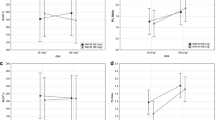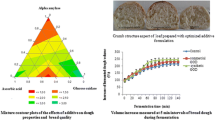Abstract
A simplex-centroid experimental design was used for the optimization of both reducing and oxidizing improvers, namely Aspergillus oryzae S2 α-amylase (Amy), ascorbic acid (Asc), and glucose oxidase (GOD). This optimization was performed to enhance the dough and breadmaking qualities of soft French wheat flour and a composite counterpart that contained 30% Ukrainian wheat flour. Statistically significant correlations were calculated between the W index and textural parameters (e.g., dough chewiness and bread cohesiveness). The findings revealed that while the best mixture for French flour comprised 21.8% of Amy, 41.2% of Asc, and 37% of GOD, for the composite counterpart, it comprised 2.3% of Amy, 66% of Asc, and 31.7% of GOD. These optimized mixtures rearranged soft French wheat flour and its composite counterpart to a good quality and an improved flour texture, respectively. Additionally, they increased the loaf specific volumes of the breads made from soft French wheat flour and its counterpart by 25.8 and 45.43%, respectively, significantly decreased the breads’ susceptibility to microbial contamination, and reclassified the breads as “good” in terms of sensory attributes.
Similar content being viewed by others
References
Barak S, Mudgil D, Khatkar BS. Relationship of gliadin and glutenin proteins with dough rheology, flour pasting and bread making performance of wheat varieties. LWT-Food Sci. Technol. 51: 211–217 (2013)
Sahnoun M, Naili B, Elgharbi F, Kammoun R, Gabsi K, Bejar S. Effect of Aspergillus oryzae CBS 819.72 a-amylase on rheological dough properties and bread quality. Biologia 68: 808–815 (2013)
Patel MJ, Ng JHY, Hawkins WE, Pitts KF, Chakrabarti-bell S. Effects of fungal a-amylase on chemically leavened wheat flour doughs. J. Cereal Sci. 56: 644–651 (2012)
Hemalatha MS, Prasada, Rao UJS, Leelavathi K, Salimath, PV. Influence of amylases and xylanase on chemical, sensory, amylograph properties and microstructure of chapatti. LWT-Food Sci. Technol. 43: 1394–1402 (2010)
Raghu KS, Bhattacharya S. Finger millet dough treated with a-amylase: Rheological, physicochemical and sensory properties. Food Res. Int. 43: 2147–2154 (2010)
Gomes-Ruffi CR, da Cunha RH, Almeida EL, Chang YK, Steel CJ. Effect of the emulsifier sodium stearoyl lactylate and of the enzyme maltogenic amylase on the quality of pan bread during storage. LWT-Food Sci. Technol. 49: 96–10 (2012)
Goesaert H, Leman P, Bijttebier A, Delcour JA. Antifirming effects of starch degrading enzymes in bread crumb. J. Agr. Food Chem. 57: 2346–2355 (2009)
Every D, Simmons L, Sutton KH, Ross M. Studies on the mechanism of the ascorbic acid improver effect on bread using flour fractionation and reconstitution methods. J. Cereal Sci. 30: 147–158 (1999)
Koehler P. Effect of ascorbic acid in dough: Reaction of oxidized glutathione with reactive thiol groups of wheat glutelin. Food Chem. 51: 4954–4959 (2003)
Vania O, Weibiao Z. Frozen bread dough. Effect of freezing storage and dough improvers. J. Cereal Sci. 45: 1–17 (2007)
Pescador-Piedra JC, Farrera-Rebollo RR, Calderón-Domínguez G. Effect of glucose oxidase and mixing time on soluble and insoluble wheat flour protein fractions: Changes on SH groups and H2O2 consumption. Food Sci. Biotechnol. 19: 1485–1491 (2010)
Bonet A, Rosell CM, Caballero PA, Gómez M, Perez-Munuera I, Lluch MA. Glucose oxidase effect on dough rheology and bread quality: A study from macroscopic to molecular level. Food Chem. 99: 408–415 (2006)
Rosell CM, Wang J, Aja S, Bean S, Lookhart G. Wheat flour proteins as affected by transglutaminase and glucose oxidase. Cereal Chem. 80: 52–55 (2003)
Steffolani ME, Ribotta PD, Pérez GT, León AE. Effect of glucose oxidase, transglutaminase, and pentosanase on wheat proteins: Relationship with dough properties and breadmaking quality. J. Cereal Sci. 51: 366–373 (2010)
Scheffe H. Simplex-centroid designs for experiments with mixtures. J. R. Stat. Soc. B Met. 25: 235–263 (1963)
Sahnoun M, Bejar S, Sayari A, Triki MA, Kriaa M, Kammoun R. Production purification and characterization of two a-amylase isoforms from a newly isolated Aspergillus oryzae strain S2. Process Biochem. 47: 18–25 (2011)
AACC. Approved Methods of the AACC. 10th ed. Methods 44-15A, 46-11A, and 54-30. American Association of Cereal Chemists, St. Paul, MN, USA (2000)
Collar C, Bollain C. Impact of microbial transglutaminase on the viscoelastic profile of formulated bread doughs. Eur. Food Res. Technol. 218: 139–146 (2004)
Bourne MC. Texture profile analysis. Food Technol.-Chicago 32: 62–66 (1978)
Nishinari K, Kohyama K, Kumagai H, Funami T, Bourne MC. Parameters of texture profile analysis. Food Sci. Technol. Res. 19: 519–521 (2013)
Valerio F, de Bellis P, Lonigro SL, Visconti A, Lavermicocca P. Use of Lactobacillus plantarum fermentation products in bread-making to prevent Bacillus subtilis ropy spoilage. Int. J. Food Microbiol. 122: 328–332 (2008)
Hrušková M, Hanzlíková K, Varáèek R. Wheat and flour quality protein in a commercial mill. Czech J. Food Sci. 19: 189–195 (2000)
Gambaro A, Gimanez A, Ares G, Gilardi V. Influence of enzymes on the texture of brown Pan bread. J. Texture Stud. 37: 300–314 (2006)
Caballero PA, Gómez M, Rosell CM. Improvement of dough rheology, bread quality and bread shelf-life by enzymes combination. J. Food Eng. 81: 42–53 (2007)
Caballero PA, Gómez M, Rosell CM. Bread quality and dough rheology of enzyme-supplemented wheat flour. Eur. Food Res. Technol. 224: 525–534 (2007)
Wieser H. Chemistry of gluten proteins. Food Microbiol. 24: 115–119 (2007)
Bordes J, Branlard G, Oury FX, Charmet G, Balfourier F. Agronomic characteristics, grain quality and flour rheology of 372 bread wheats in a worldwide core collection. J. Cereal Sci. 48: 569–579 (2008)
Hassan YI, Bullerman LB. Antifungal activity of Lactobacillus paracasei ssp. tolerans isolated from a sourdough bread culture. Int. J. Food Microbiol. 121: 112–115 (2008)
Vukic M, Hadnadev M, Tomic J, Mastilovic J, Torbica A, Grujic R. Alveograph and bread making quality of wheat dough as affected by added glucose oxidase. Qual. Life Res. 4: 49–54 (2013)
Sluimer P. Principles of breadmaking: Functionality of raw materials and process steps. AACC Press, St. Paul, MN, USA. pp. 25–38 (2005)
Author information
Authors and Affiliations
Rights and permissions
About this article
Cite this article
Sahnoun, M., Kriaa, M., Besbes, S. et al. Optimization of Aspergillus oryzae S2 α-amylase, ascorbic acid, and glucose oxidase combination for improved French and composite Ukrainian wheat dough properties and bread quality using a mixture design approach. Food Sci Biotechnol 25, 1291–1298 (2016). https://doi.org/10.1007/s10068-016-0203-7
Received:
Revised:
Accepted:
Published:
Issue Date:
DOI: https://doi.org/10.1007/s10068-016-0203-7




